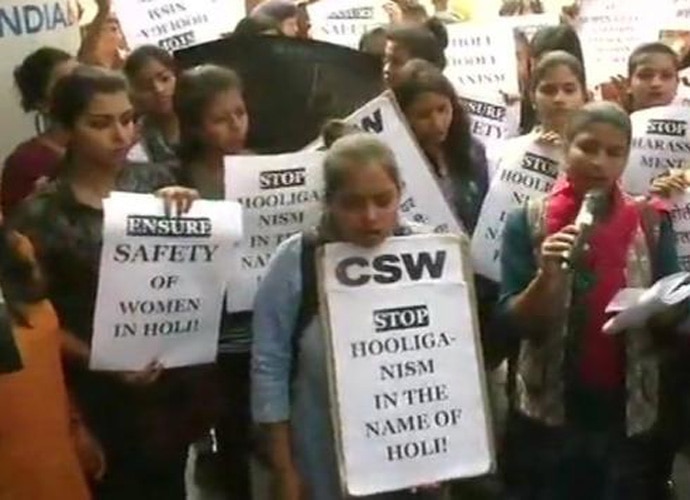How violence is becoming the new normal in India

Violence as a phenomenon has changed deeply in its character.
A few days before Holi, I saw a picture of a group of college girls from Delhi protesting about the usual Holi violence. The slogan they had was interesting. They were protesting against the normalisation of violence, of violence being ritualised and accepted as a part of everyday life.
The slogan cut across the usual rhetoric and offered a powerful piece of sociological insight. The students recognised that what is dangerous today is the way we accept violence as normal, routine and expected. It was the routinisation of violence as something legitimate and expected that they were objecting to.
Domestic space
Their note of protest provides the trigger to this essay. Violence as a phenomenon has changed deeply in its character. In India, it is not technology that has transformed violence. It is the fact that violence from an act of production is now an epidemic source of consumption. We celebrate violence and replay it endlessly.

Secondly, in consuming violence, we amplify the silence, the space of indifference around the victim. Thirdly, we legitimise indiscriminate violence, believing it offers a solution to history’s wrongs. One senses this across the range of our society, such that one needs an intellectual cartography of violence.
Let us begin with the domestic space. There have been innumerable protests about rape, but little is said about incest rape. In fact, we are coy about even providing statistics on this.
With increasing urbanisation, gang rapes have become common. Yet media reports it as an urban ritual, providing little commentary on it. But even more distressing is the rape and murder of minors. In fact, the reports are so stunningly frequent, they appear standardised. There is hardly any protest and society does not respond to their innovativeness of violence as pathological.
I remember a few decades back, there used to be a news report “Women’s Necklace Grabbed in City.” People used to joke that it happened every day. Sadly we confer the same normalcy to atrocities on minors. There is little sense of outrage, and media indifference makes one feel that it is more emotional about the weather. There is little sense of horror or nausea. It is as if we are embarrassed to report such incidents.
The school as a source of violence in its variety hardly seems to bother educationists. The reaction is a combination of helplessness and indifference and after a while, we routinise it into our lives.
I remember a few decades ago, the human rights activist Mark Muzel brought to the attention of the UN the plight of the Ache Indians. A dam was coming up in that region and the tribe was seen as an obstacle. When Munzel’s complaint was discussed, the Ambassadors of Paraguay and Brazil admitted there had been violence, but added that it was a normal part of development.
Development as a normalcy underwrites violence. One senses it in India, where development projects, particularly dams, have displaced over 40,000,000 people.
Complex problem
The staggering nature of the statistic hardly bothers people who read such violence as routine, even logical and inevitable. Another factor that has normalised violence in India is majoritarianism. A majoritarian democracy is often an oxymoron. When a majority comes into power, it often violates the rights of minorities, margins, dissenters almost as a right.
It sees violence as legitimate, a normaliser. It is more like a balancing of mechanical systems than an effort to confront the ethics or aesthetics of violence. One witnessed this process in the Gujarat violence of 2002 where the government talked of a return to normalisation. The majority and the perpetrators of the riots demanded that the victim erase the riot from memory.
Questions of justice and rights suddenly seemed irrelevant. The government asked ethnic groups to abandon their identity, their sense of injustice and join the bandwagon of development. Here, normalcy becomes an act of erasure. Indifference and erasure become two rituals that facilitate normalisation of violence. What adds insult to injury in the normalisation process is that often, people protest in favour of the perpetrator, ignoring the pain of the victim.
The normalisation of violence is thus a complex phenomenon, where violence is not only routine but seen as expected and acceptable.
Casual slang
The very language of genocide and revolution that justified large-scale violence has today become a part of everyday life. We talk of body counts as if it is casual slang. Worse, the topic of numbers does not move us today. It is as if numbers benumb our sensitivity. The question is what does one say when large violence becomes an acceptable ritual?
Are we ready to accept the fact that ordinary men participate as happily in a festival of lynching as in a celebration of Holi?
All I can see as a resistance to it is a return to Gandhian ethics, where the body becomes the site of Satyagrahic struggle. Till then, we have to stand in the streets and protest against the normalisation of violence. Suddenly ordinary goodness seems almost effete against the inventive power of violence. Such is the corrosive power of “normalisation.”
(Courtesy of Mail Today)

